Related Research Articles
The Enlisted Aviation Warfare Specialist (EAWS) insignia is a military badge of the United States Navy which was created in March 1980. The insignia recognizes those members of the Navy's enlisted force who have acquired the specific professional skills, knowledge, and military experience that result in qualification for service in the aviation activities of the Navy. This includes most personnel who are trained flight deck personnel onboard aircraft carriers, or maintenance personnel at an Aircraft Intermediate Maintenance Detachment or Department (AIMD) or aircraft squadron.
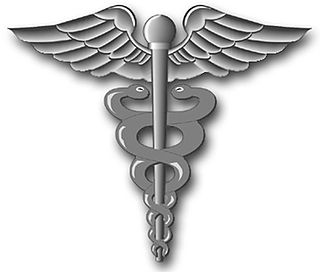
A hospital corpsman is an enlisted medical specialist of the United States Navy, who may also serve in a U.S. Marine Corps unit. The corresponding rating within the United States Coast Guard is health services technician (HS).
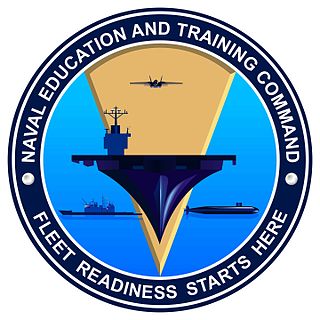
The Naval Education and Training Command (NETC) is an enterprise level shore command of the United States Navy with more than 19,000 military and staff personnel at more than 1,640 subordinate activities, sites, districts, stations, and detachments throughout the world.

Machinist's mate is a rating in the United States Navy's engineering community.

A United States Navy diver refers to a service personnel that may be a restricted fleet line officer, civil engineer corps (CEC) officer, Medical Corps officer, or an enlisted who is qualified in underwater diving and salvage. Navy divers serve with fleet diving detachments and in research and development. Some of the mission areas of the Navy diver include: marine salvage, harbor clearance, underwater ship husbandry and repair, submarine rescue, saturation diving, experimental diving, underwater construction and welding, as well as serving as technical experts to the Navy SEALs, Marine Corps, and Navy EOD diving commands.
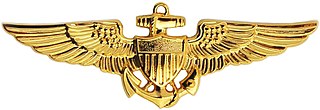
A naval aviator is a commissioned officer or warrant officer qualified as a crewed aircraft pilot in the United States Navy or United States Marine Corps. United States Coast Guard crewed aircraft pilots are officially designated as "Coast Guard aviators", although they complete the same undergraduate flight training as Navy and Marine Corps crewed aircraft pilots, and are awarded the same aviation breast insignia.
A parachute rigger is a person who is trained or licensed to pack, maintain or repair parachutes. A rigger is required to understand fabrics, hardware, webbing, regulations, sewing, packing, and other aspects related to the building, packing, repair, and maintenance of parachutes.
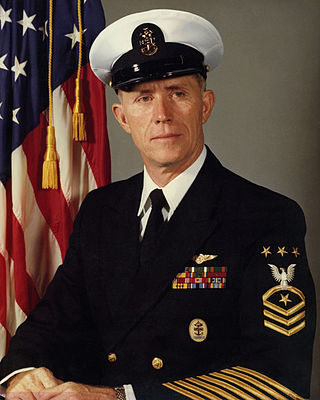
Billy C. Sanders is a retired senior sailor of the United States Navy who served as the fifth Master Chief Petty Officer of the Navy.

Aviation electronics technician (AT) is a US Navy enlisted rating or job specialty. At the paygrade of E-9, ATs merge with the aviation electrician's mate (AE) rating to become avionics technicians (AV). There has been talk of completely merging the two ratings, but as yet no definite plans have been announced. Aviation electronics technicians wear the specialty mark of a winged helium atom.
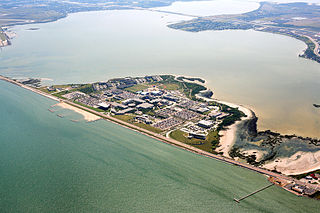
Ward Island is a small body of land situated at the confluence of Corpus Christi Bay and Oso Bay and is part of the city of Corpus Christi, Texas. Most of Ward Island is now used by Texas A&M University-Corpus Christi.
The PNS Karsaz is the naval station and the largest technical training facility located in the urban neighborhood of Karsaz in Karachi that provides technical education on the subjects of the mechanics and the electronics for the Navy's enlisted personnel upon their passing out from the PNS Himalaya— the Navy's only basic training boot camp in Manora Island in Karachi coast, Sindh in Pakistan.

Nuclear Power School (NPS) is a technical school operated by the U.S. Navy in Goose Creek, South Carolina as a central part of a program that trains enlisted sailors, officers, KAPL civilians and Bettis civilians for shipboard nuclear power plant operation and maintenance of surface ships and submarines in the U.S. nuclear navy. As of 2020 the United States Navy operates 98 nuclear power plants, including 71 submarines, 11 aircraft carriers, and three Moored Training Ships (MTS) and two land-based training plants. NPS is the centerpiece of the training pipeline for U.S. Navy nuclear operators. It follows initial training at Nuclear Field "A" School or a college degree, and culminates with certification as a nuclear operator at one of the Navy's two Nuclear Power Training Units (NPTU). As of 2020, since training the crew of the first nuclear powered vessel in 1952, the Program has trained and qualified over 142,000 nuclear propulsion plant operators. Since 1955, when Nautilus first got underway on nuclear power, Navy nuclear powered vessels have safely steamed over 166 million miles.

William Crawford Eddy was a Naval officer, submariner, engineer, television producer, educator, cartoonist, artist, inventor, entrepreneur, explorer and writer.
Naval Air Technical Training Center Ward Island is a decommissioned United States Navy base located on Ward Island, just offshore from Corpus Christi, Texas. During World War II (WWII), this base provided highly classified airborne electronics maintenance training for many thousands of Navy, Marine, Coast Guard, and Royal Air Force personnel.

The United States Navy job rating of electronics technician (ET) is a designation given by the Bureau of Naval Personnel (BUPERS) to enlisted members who satisfactorily complete initial Electronics Technician "A" school training.

Electronics technicians help design, develop, test, manufacture, install, and repair electrical and electronic equipment such as communication equipment, medical monitoring devices, navigational equipment, and computers. They may be employed in product evaluation and testing, using measuring and diagnostic devices to adjust, test, and repair equipment. Electronics technicians may also work as sales workers or field representatives for manufacturers, wholesalers, or retailers giving advice on the installation, operation, and maintenance of complex equipment and may write specifications and technical manuals. Electronics technicians represent over 33% of all engineering technicians in the U.S. In 2009, there were over 160,000 electronics technicians employed in the U.S. Electronics technicians are accredited by organizations such as the Electronics Technicians Association (ETA), or International Society of Certified Electronics Technicians (ISCET).
The Radio Materiel School (RMS), operated by the United States Navy, was the first electronics training facility of America’s military organizations. During the 1920s and 1930s, it produced the core of senior maintenance specialists for the Navy’s communication equipment that “paved the way to United States world leadership in electronics.”
Nelson Magor Cooke was a leader in developing electronic schools of the United States Navy, the recipient of the Navy Commendation Medal and Medal for Humane Action, a post-war engineering entrepreneur, and an author of books on applied mathematics and basic electronics.
The Electronics Training Program (ETP) was the name commonly used for an unusual, difficult, and selective training activity of the United States Navy during World War II.
References
- ↑ Pierrepoint, J. J., J. S. Weigand, and N. M. Cooke; "Preparation for Candidates, Radio Materiel School", Naval Research Laboratory, 1934
- ↑ Jurgen, Ronald K. (November 1975). "Captain Eddy: the man who launched a thousand EEs", IEEE Spectrum , pp. 53–56.
- ↑ Whiteside, George W. (July 1943). "Naval Training School – EE&RM", Oklahoma A&M College Magazine.
- ↑ Watson, Raymond C. Jr. (2007). Solving the Naval Radar Crisis, Trafford Publishing.
- ↑ McDevitt, E. A. (editor); The Naval History of Treasure Island, U.S. Navy Training Center, Treasure Island, California.
- ↑ Genochio, Frank Albert (1949). "The Training of Navy Electronics Technicians" Thesis, School of Education, Stanford University.
- ↑ Stalnaker, John M. (1944). "Construction and Applications of Psychological Tests in the Armed Services", Review of Educational Research, vol. 14, no. 1, pp. 102–109.
- ↑ "Navy establishes New Radio School". Chicago Daily Tribune , January 13, 1942. p. 7.
- ↑ "Loop Sailors", Time , March 23, 1942.
- ↑ Eddy, Lieut. Comdr. W. C., et al.; Wartime Refresher in Fundamental Mathematics, Prentice–Hall, 1945.
- ↑ Watson, op. cit.
- ↑ Lange, Henry (March 25–28, 1985). "The Eddy Genius", four-part series on William Crawford Eddy, The News-Dispatch , Michigan City, Indiana.
- ↑ Legion of Merit Citation, William Crawford Eddy, Captain, USNR. December 1945
- ↑ Op. cit., Lange/Eddy
- ↑ The Otis Test (sometimes called the Otis Higher Examination or the Otis Measure of Brightness) was taken by essentially all persons entering the U.S. Navy, and was used in assessing basic capabilities for attending training programs.
- ↑ Test and Research Staff, Bureau of Naval Personnel (March 1, 1946). "Psychological test construction and research in the Bureau of Naval Personnel – Part V, Navy radio technician training program", American Psychologist , vol. 1, no. 3, pp. 80–90.
- ↑ Cooke, Nelson M. (December 1943). "Mathematics in the Navy Radio Program", The Mathematics Teacher , vol. 36, p. 329.
- ↑ Cantrell, Psyche (June 1930). "IQ's and the Otis Measure of Brightness", The Journal of Educational Research , vol. 22, no 1, pp. 31–35.
- ↑ Stauffer, Artie John (1952). "Electronic Technician Selection Test", Ed.D. dissertation, Teachers College, Columbia University.